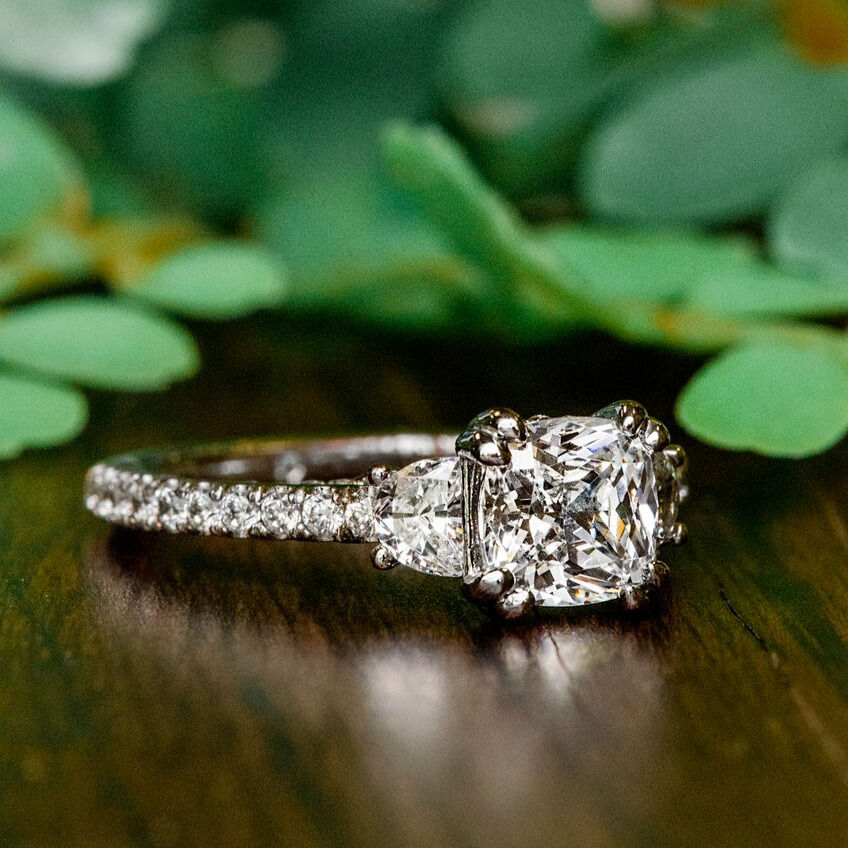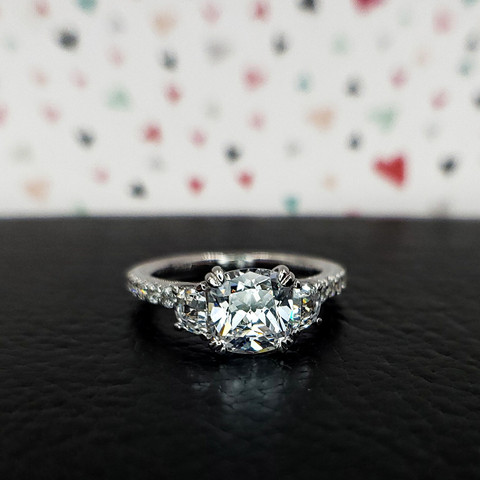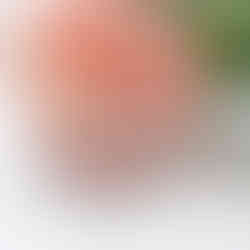
Cushion cuts are not only one of the oldest cuts of diamond; they are also one of the most pleasing. Named for their pillow-like shape, the cushion cut is a modification on a square cut diamond.
Most cushion cut diamonds don’t have defined corners like squares, but rather, flaunt gently rounded corners and sides that bulge subtly forth beyond the ring’s prongs. The look of a cushion cut diamond is uniquely voluptuous, soft, and undeniably romantic.

While cushion cut diamonds are hugely popular with the modern bride, the truth is these stones are absolute classics. Cushions have such a rich history that many of the world’s oldest and most famous gemstones (such as The Hope Diamond), are actually cushion cuts. In fact, while round brilliants have become the poster-child of the diamond world, cushion cuts actually predate round diamonds by hundreds of years.
Simply put, you’d be hard pressed to find a diamond style with more pedigree than the cushion.

But despite the enduring allure of this incredible cut, cushion cut diamonds continue to be one of the most challenging types of diamond to buy. The reason is simple: diamond cutters sometimes take shameful liberties with this particular cut of stone.
To understand why, you might need a little brush up on your geology. It turns out that diamond crystals actually grow in a square pattern, so diamond cutters begin with a square-ish shape of raw material. When cutters set working on this material, they really have two jobs:
Job 1: to create the most high quality, dazzling, finished stone possible.
This means analyzing the raw diamond material to work around inclusions.
It means being meticulous and precise about the angle of each and every facet.
It means planning each proportion to maximize the diamond’s reflective properties.
Job 2 is to retain as much of that original raw material as possible.
Remember, diamonds are sold by carat weight. Diamond is the rarest and most expensive material known to man, so no one is looking to waste this precious material by cutting away too much of it.
Job 2 often gets in the way of job 1, and so, cutters will often compromise the proportions of the diamond in an effort to keep as much weight on the finished stone as possible.
The trouble is, a diamond cut too deeply will look dark and dull. From above, it will also seem small for its weight.
A diamond cut too shallow might look large for its carat weight due to the disproportionately wide cut of its table. At first look, this diamond might even appear bright in color. But it won’t sparkle. The effect will be watery, lifeless and over time, increasingly disappointing.
Cushion cut diamonds don’t have the same exacting requirements of round brilliants. Because they are not quite round and not quite square, there is more wiggle room in how these shapes are cut. Sometimes that means diamond cutters take liberties with these shapes that they cannot take with the more mandated styles.
Still, a well-proportioned cushion cut diamond has a beauty worth seeking. It will sparkle. It will sizzle. And its softened edges will be demure and pleasing in a way that no other shape can really boast.
So how do you shop for a cushion cut diamond to be sure you are getting a stone that is truly worth its weight?
(Luckily, this part is pretty easy...)
Step 1:
Ask to see a round brilliant diamond. If possible, keep this round brilliant on hand as you look at cushion cut stones.
The crown and the girdle of your cushion cut diamond should mirror the proportions of the round diamond.
In other words, if the facets on the crown of your cushion cut go almost straight up and down, that’s bad.
If the girdle on your cushion cut is noticeably thicker than the girdle of the round, that too, is bad.
High crowns and thick girdles are two of the most common ways that diamond cutters will retain carat weight, while actually compromising the sparkle and beauty of the stone.
Step 2:

This technique, though not a scientific way to determine the cut grade of the stone, is a fabulous way to help you rule out those poorly proportioned cushion cut diamonds.
Hold your cushion cut diamond with tweezers, and place your hand beneath the stone. Can you see your skin tone through the diamond?
If so, that’s bad.
All light that passes into a diamond, ideally, should reflect right back out the top of that diamond. If it doesn’t, then the diamond won’t sparkle the way it should, and it will appear darker or yellower than desirable once it’s in a mounting.
Perhaps while diamond shopping you’ve heard a salesperson talk about ‘windows’. Windows in diamonds are not like windows in your house. A window on your house lets light in. A window in your diamond lets light out. In diamond speak, windows are bad, and they are what you are looking for when you do the skin tone test. If you can see your skin tone through the diamond, that diamond is leaking a lot of light.
A well-cut diamond, on the other hand, will be reflective and so will always appear bright, white, and sparkling regardless of what’s behind it.

Cushion cut diamonds are another prime example of how cut overrides color or clarity when determining the beauty of a diamond. The clearest, most colorless stone will still be lifeless if the cut is off.
No grading report can tell you whether a diamond is well cut. For that reason, cushion cut diamonds are not diamonds to buy online. They are diamonds you must see in person. They are diamonds to buy from a trusted jeweler.
If you’re interested in a cushion cut stone, don’t be shy or accommodating. Ask to see a lot of cushion cuts. Ask to see them next to rounds. Go to multiple jewelers. It may take some time, but the market is inundated with poorly cut cushions and you don’t want to be had. Besides, what’s a little time when this is a purchase she’ll be wearing for the rest of her life?
Once you've found the diamond of your dreams, check out some of our favorite ways to mount this timeless cut!
















Comments